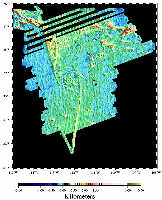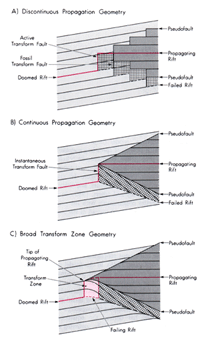
Earth's Fastest Spreading Ridge
Hawaii Institute of Geophysics and Planetology
Earth’s Fastest Seafloor Spreading Center:
28°S–32°S East Pacific Rise

Click on the above image to see a full-size version of the 29° overlap zone color-shaded relief map, with caption, from Hey et al. (1995). |

Click on the above image to see a full-size version of EPR Segment E4 data, with caption, from Hey et al. (2004). This paper is available as a PDF (click here to download now). |

Click on the above image to see a full-size version of various models of propagating rift geometry, with caption. |
Some of our recent research involves hydrothermal and structural investigations along Earth’s fastest seafloor spreading center, the 28°S–32°S East Pacific Rise. The fastest present-day seafloor spreading, ~150 km/Myr, occurs along the Pacific-Nazca boundary between the Easter and Juan Fernandez microplates. These rates use the revised astronomically calibrated timescale so the rates given here are ~6% slower than previously thought. We had previously surveyed parts of this area with SeaBeam and SeaMARC II, and in 1993 we surveyed the area using the new GLORIA system (GLORI-B), now capable of collecting swath bathymetry as well as sidescan data, and with SeaBeam 2000 (see color figure). Our principle conclusion is that a large-offset propagating rift is reorganizing the plate boundary geometry, with rift failure characterized by rapid, large-scale, quasi-periodic episodes of duelling propagation just before spreading ceases. The present episode has created a huge overlap zone between dual active spreading centers which may be the initial stage of formation of a new microplate, similar to a scaled-up model C (at lower right) but with both ridges propagating towards each other.
With these previous results as a guide, in March–April 1998, we conducted a detailed geophysical/reconnaissance hydrothermal investigation of the ridge axes in this area. This was a collaborative effort with the NOAA PMEL group led by Ed Baker and John Lupton. The principle geophysical survey technique was the WHOI DSL-120 kHz side-scan sonar/swath bathymetry system. The principle hydrographic techniques were CTDs used in the tow-yo mode, the PMEL SUAVE system mounted on the 120 depressor weight, and vertical CTD casts to collect water samples. We also conducted camera tows in hydrothermally active areas and photographed vent sites on four spreading segments. This was the first rigorous correlation between co-registered hydrothermal plume and marine geophysical data on similar scales and over multi-segment distances (Baker et al., 2002; Walker et al., 2004; Hey et al., 2004).
The degree of hydrothermal activity corresponds more closely to high frequency variations in the rate of magma supply, especially cross-sectional inflation area, than low-frequency variations (e.g., spreading rate). Axial inflation is the best predictor of hydrothermal activity at these “superfast” rates. These data show that these are some of the most hydrothermally active ridge axes yet explored, with significant hydrothermal plume variability on a timescale of a few days. Fracture patterns observed in the sidescan data define natural segmentation scales along these ridge segments. These sometimes, but not always, correlate with linear volcanic systems defining segmentation in the Sea Beam data. Some of the sub-segments behave cohesively, with in-phase tectonic activity, while fundamental discontinuities occur between other sub-segments. Major plume concentrations were usually found where axial inflation was relatively high and fracture density was relatively low. These correlations suggest that hydrothermal venting is most active where the apparent magmatic budget is greatest, resulting in recent eruptions that have paved over the neovolcanic zone. Areas of voluminous acoustically dark young lava flows produced from recent fissure eruptions correlate with many of the major hydrothermal vent areas. Increased crustal permeability, as gauged by increased fracture density, does not enhance hydrothermal venting in this area. Neither is an axial graben a predictor of hydrothermal activity, as only ~20 km of graben exist along the entire survey area. Many of the hydrothermal areas are found in inflated areas near the ends of segments, suggesting that abundant magma is being supplied to these areas.
Movies of the sidescan data we collected over 600 km of ridge axis were originally presented by Hey et al. (2001). Subsequent substantial improvements by Del Bohnenstiehl at North Carolina State University resulted in a series of Fledermaus movies of sidescan draped on bathymetry, with the summed MAPR nephelometer data from four sensors deployed on the tow wire. The hydrothermal vent geology and biology at Earth‘s fastest spreading rates are described in Hey et al. (2006).
Publications
- Naar, D.F. and R.N. Hey, Speed limit for oceanic transform faults, Geology, 17, 420-422, 1989.
- Naar, D.F. and R.N. Hey, Speed limit for oceanic transform faults, Geology, 17, 420-422, 1989.
- Naar, D.F. and R.N. Hey, Recent Pacific-Easter-Nazca plate motions, in Evolution of Mid-Oceanic Ridges, Geophysical Monograph Series, AGU, 9-30, 1989.
- Klaus, A., W. Icay, D.F. Naar, and R.N. Hey, SeaMARC II survey of a propagating limb of a large non-transform offset near 29°S along the fastest spreading East Pacific Rise segment, J. Geophys. Res., 96, 9985-9998, 1991.
- Hey, R.N., P.D. Johnson, F. Martinez, J. Korenaga, M.L. Somers, Q.J. Huggett, T.P. LeBas, R.I. Rusby, and D.F. Naar, Plate boundary reorganization at a large-offset, rapidly propagating rift, Nature, 378, 167-170, 1995.
- Korenaga, J. and R.N. Hey, Recent dueling propagation history at the fastest spreading center, the East Pacific Rise, 26°–32°S, J. Geophys. Res., 101, 18023-18041, 1996.
- Martinez, F., R.N. Hey, and P.D. Johnson, The East ridge system 28.5°–32°S East Pacific rise: Implications for overlapping spreading center development, Earth and Planet. Sci. Lett., 151, 13-31, 1997.
- Hey, R.N., Subtle error on sea floor, Nature, 396, 210, 1998.
- Pardee, D.R., R.N. Hey, and F. Martinez, Cross-sectional areas of mid-ocean ridge axes bounding the Easter and Juan Fernandez microplates, Mar. Geophys. Res., 20, (1998), 517-531, 2000.
- Hey, R.N., Propagating Rifts and Microplates, in Encyclopedia of Ocean Sciences, eds. J.H. Steele, S.A.Thorpe, and K.K. Turekian, Academic Press, London, Volume 4, 2300-2308, 2001.
- Hey, R.N., E. Baker, J. Lupton, M. Kleinrock, F. Martinez, D. Naar, D. Bohnenstiehl, D. Pardee, G. Massoth, C. Rodrigo, S. Gegg, T. Reed, and A. Andersson, Fine-Scale volcano-tectonic patterns along the hotspot and non-hotspot influenced fastest spreading parts of the East Pacific Rise, and their relation to hydrothermal activity, Eos Trans. AGU, 82, F1218, 2001.
- Baker, E.T., R.N. Hey, J.E. Lupton, R.A. Feely, J.J. Gharib, G.J. Massoth, J.A. Resing, F.J. Sansone, M. Kleinrock, F. Martinez, D. Naar, C. Rodrigo, D. Bohnenstiehl, and D. Pardee, Hydrothermal venting along Earth’s fastest spreading center: East Pacific Rise, 27.5°–32.3°S, J. Geophys. Res., v. 107, No. B7, EPM2, 1-14, 10.1029/2001JB000651, 2002.
- Walker, S.L., E.T. Baker, G.J. Massoth and R.N. Hey, Short-term variations in the distribution of hydrothermal plumes along a superfast spreading center, East Pacific Rise, 2730'–3220'S, Geochem. Geophys. Geosyst., 5, Q12005, doi:10.1029/2004GC000789, 2004.
- Hey, R.N., Propagating Rifts and Microplates at Mid-Ocean Ridges, in Encyclopedia of Geology, eds. R.C. Selley, R. Cocks and I. Plimer, Academic Press, London, 396-405, 2004.
- Hey, R. N., E. Baker, D. Bohnenstiehl, G. Massoth, M. Kleinrock, F. Martinez, D. Naar, D. Pardee, J. Lupton, R. Feely, J. Gharib, J. Resing, C. Rodrigo, F. Sansone, and S. Walker, Tectonic/Volcanic Segmentation and Controls on Hydrothermal Venting along Earth’s Fastest Seafloor Spreading System, EPR 27°–32°S, Geochem. Geophys. Geosyst., Vol. 5, No. 12, Q12007, doi: 10.1029/2004GC000764, 2004.
- Hey, R.N. G.J. Massoth, R.C. Vrijenhoek, P.A. Rona, J. Lupton and D.A. Butterfield, Hydrothermal vent geology and biology at Earth‘s fastest spreading rates, Mar. Geophys. Res., doi: 10.1007/s11-1-005-1887-x, 2006.
- Bohnenstiehl, D.R., J.K. Howell and R.N. Hey, The distribution of axial lava domes along a superfast overlapping spreading center, 27–32°S on the East Pacific Rise, Geochem. Geophys. Geosyst., 9, Q12016, doi: 10.1029/2008GC002158, 2008.
- Hey, R., Seafloor Spreading, in Encyclopedia of Solid Earth Geophysics, ed. H. Gupta, Springer, Dordrecht, ISBN 978-90-481-8701-0, 1055-1059, 2011.
- Bohnenstiehl, D.R., J.K. Howell, S.M. White, and R.N. Hey, A modified basal outlining algorithm for identifying topographic highs from gridded elevation data, Part 1: Motivation and methods, Computers & Geosciences, dx.doi.org/10.1016/j.cageo.2012.04.023, 2012.
- Hey, R.N., Propagating Rifts and Microplates at Mid-Ocean Ridges, www.sciencedirect.com/science/article/pii/B978012409548903027X, in Elsevier’s Science Direct online Reference Module in Earth Systems and Environmental Sciences, ed. S. Elias, ISBN: 978-0-12-409548-9, 2013.
- Hey, R.N., Tectonics: Propagating Rifts and Microplates at Mid-Ocean Ridges, www.sciencedirect.com/science/article/pii/B978012409548903027X, in Elsevier’s Science Direct online Reference Module in Earth Systems and Environmental Sciences, ed. S. Elias, ISBN: 978-0-12-409548-9, 2015.
Oceanographic Expeditions
- ** 1983 April: Sea Beam investigation of the Easter Microplate, Easter Island-Callao, Scripps Institution of Oceanography, chief scientist R.N. Hey, R/V THOMAS WASHINGTON.
- ** 1987 October–November: SeaMARC II investigation of the Easter Microplate, Easter Island-Easter Island, Hawaii Institute of Geophysics, chief scientist R.N. Hey, R/V MOANA WAVE.
- ** 1993 February–March: GLORIA investigation of the fastest seafloor spreading center, Papeete-Easter Island, SOEST, University of Hawaii, chief scientist R.N. Hey, R/V MELVILLE.
- ** 1998 March–April: Hydrothermal and structural investigations along the fastest spreading center: The 28°–32°S EPR reorganizing plate boundary, using DSL-120 and CTD/SUAVE tows, University of Hawaii/NOAA PMEL, chief scientist R.N.Hey, R/V MELVILLE.
- 1999 January: ALVIN biological and geochemical sampling of hydrothermal vents along the fastest spreading center, EPR 31°–32°S, Easter Island-Easter Island, Rutgers University/NOAA PMEL, chief scientist R. Vrijenhoek, R/V ATLANTIS, DSV ALVIN.
- ** Chief Scientist
- * Co-Chief Scientist
Students involved in this research
- P. Johnson
- F. Martinez
- D. Naar
- A. Klaus
- W. Icay
- J. Korenaga
- M. Kleinrock
- D. Pardee
- D. Bohnenstiehl
- J. Resing
- J. Gharib
- A. Gascho
- J. Howell

